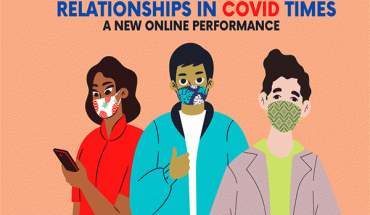Warning: This article discusses topics like rape and sexual violence that may be triggering for some readers.
When the movie Fifty Shades of Grey, starring Dakota Johnson and Jaime Dornan, opened nationwide Feb. 13, its depiction of a romantic and sexual relationship raised concerns over whether the story crosses the line into abuse.
As some called for a boycott of the film and new essays and critiques have flooded the Internet, there has been a particular focus on how the story’s messages might affect younger people at a time when rape and interpersonal violence have become ongoing issues on many college campuses.
“It normalizes stalking,” Angela Hattery, a women and gender studies professor at Mason, said. “It normalizes all those things that then might make someone who’s early in a relationship think, oh, this is romantic as opposed to potentially dangerous.”
Fifty Shades of Grey, based off the bestselling book by E.L. James, follows the burgeoning relationship between college student Anastasia Steele and older billionaire Christian Grey. As the first installment in a trilogy, the book was published in 2012 and has sold more than 100 million copies worldwide, according to Amazon. The film earned $85.2 million over its three-day opening weekend, giving it the highest grossing opening for a movie in February, though its box office plummeted in its second week in theaters.
Though the book famously started out as a Twilight fanfiction, word-of-mouth and its original e-book format helped attract mainstream attention.
“People want to read sex,” Jessica Matthews, a GMU English professor who is currently teaching a class about romance novels, said. “They hear about it, they’re going to read about it and see what it’s like.”
Hattery is teaching a class titled “Gender, Power, Violence and the Body” and says Fifty Shades of Grey’s popularity could possibly be attributed to the fact that women are often discouraged from wanting or finding pleasure in sex.
“There’s a long history of this sort of [idea] that women needed to be persuaded to have sex, that women are supposed to say no first,” Hattery said, citing a scene in the movie Gone With the Wind as an example of this attitude. In the scene in question, Rhett Butler, played by Clark Gable, throws Vivien Leigh’s Scarlett O’Hara over his shoulder and forcibly takes her to their bedroom, yet in the morning, they both appear happy despite the implied assault.
Caren Sempel, associate director for interpersonal violence education and services at WAVES, says that many of Grey’s behaviors, from tracking Ana’s phone and showing up announced to refusing to give her time and space to make her own decisions, are often signs of an abusive partner.
“The behavior that we realize later, in hindsight is so controlling, initially seems very romantic,” Sempel said. “It’s a paternalistic way of [saying] I’m protecting you. I care so much about you and know better than you do, and I just want to keep you safe. In reality, that’s not true. It’s just another tool that abusers use to control you.”
College students can find it difficult to recognize warning signs, because their experience with long-term romantic and sexual relationships tends to be more limited and they have fewer points of reference for what a healthy relationship should be like.
It is difficult to pinpoint just how much influence Fifty Shades of Grey might have. Matthews says that teens and college-aged people are not among the primary audience for romance novels, meaning that they likely learn about sex and relationships from other sources.
“Romance novels do not skew young in terms of their readership, even though plenty of women will say I learned everything I know about sex as a teenager from reading romance novels,” Matthews said.
However, Fifty Shades of Grey’s high profile suggests its reach has expanded beyond the normally niche communities of romance and erotica readers, including people who might be completely new to the genre.
“If you aren’t familiar with romance conventions, I can see where that film can come off the way it does to a lot of people,” Matthews said, adding that many of the film reviewers she has read do not appear to have read the book. “What I would hope is that, when people look at that film, they realize that in the end, she walks out. She rejects the relationship, so there is a sense that she’s on a kind of journey about her own sexuality.”
She says that, along with Anastasia’s character growth, part of Fifty Shades of Grey’s appeal comes from Christian’s wealthy lifestyle, which promises security at a time when many people, especially college students, are facing financial and employment difficulties.
“The reality is that millions of people, primarily women, really enjoyed the book and the film,” she said, “but their voices are being sort of squelched because it’s so easy to criticize the book and the film.”
Samantha Ouellette, a senior in Matthews’s class, which features Fifty Shades of Grey among its assigned readings, previously read the whole trilogy, and while she says some parts are “disturbing”, she argues that much of the criticism is misguided.
“One of the most common things I hear about people who disagree with the book is that Christian ignores the safe word,” she said, referring to debates over the story’s representation of BDSM practices. “He does not ignore the safe word. She only says it once in the entire series, and he stops immediately. That was a straight-out lie, and people are posting it all over [online].”
Another student in Matthews’s class, junior Kasey Schoenike, says she had reservations about reading the book but found the actual experience to be fast, due to James’s straightforward, accessible writing style, and “eye-opening”, though she agrees with criticisms that Christian’s and Ana’s relationship is an abusive one.
“It’s hard to say that what’s popular in our society doesn’t have an effect on us, because we take all of that and ingrain it,” Shoenike said. She mentioned a recent incident where a University of Illinois at Chicago student charged with sexually assaulting a female student said he was reenacting a scene from the film.
“I don’t necessarily think that’s fair as an example,” she added, “because not everyone’s going to be an extreme. For people to say it’s going to give everyone who reads it a bad idea of relationships, I think, is really unfair.”
Both students say that judgment of Fifty Shades of Grey and those who like it seems heightened, because its audience consists largely of women, and it comes from a genre that often gets marginalized.
“You do have these really educated women who are not only reading romance novels, but they’re also writing them,” Schoenike said, arguing against the widespread perception of romance as inherently frivolous.
“Men surf porn all the time, and most people don’t talk about that,” Ouellette said, “but the moment a woman picks up a romance book, everybody’s giving her a funny look. People make assumptions about your intelligence. It’s incredibly insulting all around, especially when people are making judgments on the book when they haven’t read it.”
Ouellette does not completely agree with fears that the story will lead more readers to mistake abuse for romance.
“It’s kind of rude to the people who are reading it, that they can’t tell the difference between a healthy and unhealthy relationship,” Ouellette said. “It’s a fantasy. It’s something that we go to. It’s safe to think about in the confines of a book, but you don’t bring [it] outside.”
Featured photo credit: Amy Rose




